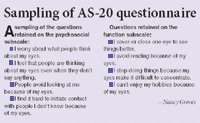Article
Survey assesses life quality for adults with strabismus
A 20-item questionnaire is expected to be useful for evaluating the health-related quality of life of adults with strabismus and practical application in a clinical setting. The patient-derived questionnaire assesses both psychosocial and functional aspects of strabismus.

Key Points

"Strabismus can affect both social and emotional functioning in adults, and strabismus management often aims to address these and other effects of strabismus on quality of life," said Hatt, a research orthoptist, Department of Ophthalmology, Mayo Clinic College of Medicine, Rochester, MN. "Yet, formal assessment of the quality of life aspect of strabismus in adults is rarely performed in the clinical setting. So we aim to develop and validate a health-related QOL questionnaire for adults with strabismus."
The team developing the questionnaire had several objectives in mind, Hatt said.
The process began with interviews of adults with strabismus to derive specific concerns regarding quality of life. Each concern identified was converted into a question. The individual interviews with 30 patients resulted in 181 questions. Next, the team asked 29 patients to complete the preliminary 181-item questionnaire as a first step toward reducing it to a more manageable number of core questions.
A study on the first phase of development of the questionnaire was published in November 2007 in the American Journal of Ophthalmology.
The 29 patients were asked to rate each question as never, rarely, sometimes, often, always, or not applicable. Item reduction criteria then were applied, such as identifying questions to which more than 10% of the responses were "not applicable." These questions were deleted. The reviewers also removed questions to which more than 80% of the responses were "rarely" or "never"-indicating that quality of life in those areas was good.
Patients also were invited to comment on the wording and clarity of the questions, and any item that had one or more negative comments was excluded. Any question that would become inapplicable after intervention also was removed, as were any that might seem discriminatory in terms of socioeconomic status, education, or cultural background. Lastly, any questions that were more descriptive of symptoms than quality of life were removed, resulting in a reduction from 181 to 49 items.

To assess the validity of the AS-20, researchers asked adults with strabismus (n = 32), subjects with normal vision (n = 13), and subjects with other eye diseases (n = 18) to complete the questionnaire. The team calculated a mean score for each participant, an overall score for all 20 items, and a score for each subscale. The range was from 0 (the worst quality of life) to 100 (the best quality of life). The median, overall, and subscale scores were compared for each of the three subject groups.
In the strabismus group, 22 patients had diplopia, whereas 10 did not. The group included patients with a wide range of diagnoses, such as incomitant and concomitant forms of strabismus. The median age was 46.5 years.
Newsletter
Don’t miss out—get Ophthalmology Times updates on the latest clinical advancements and expert interviews, straight to your inbox.




